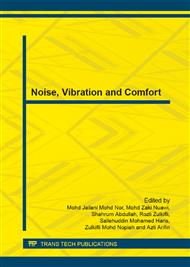p.9
p.14
p.20
p.25
p.30
p.35
p.40
p.45
p.52
Measurement of Vibration Power Flow through Elastomeric Powertrain Mounts in Passenger Car
Abstract:
The effectiveness of vibration isolator or mount can be done by quantifying the vibration energy flow through the isolators. This can provide information on the quantification of the vibration energy flow from the powertrain to the structure or chassis. Vibration energy flow through mount is identified as vibration power flow that is one of vibration transmission paths. This paper presents vibration power flow through four elastomeric mount. The vibration (source and receiver of accelerations) was measured by running engine at constant speed and without load conditions in varying speeds starting from 1050 RPM to 4000 RPM. The vibration was measured only in z-direction (vertical direction). The noise inside compartment was measured at the condition of engine run-up without load condition and was measured starting from 1050 RPM to 4000 RPM engine speed. The results from vibration power flow analysis showed that the main vibration energy transmission was high from front mount and rear mount, around engine speed 3200 RPM, and booming noise occurred around 3200 RPM due to structure-borne noise.
Info:
Periodical:
Pages:
30-34
Citation:
Online since:
December 2013
Price:
Сopyright:
© 2014 Trans Tech Publications Ltd. All Rights Reserved
Share:
Citation:


